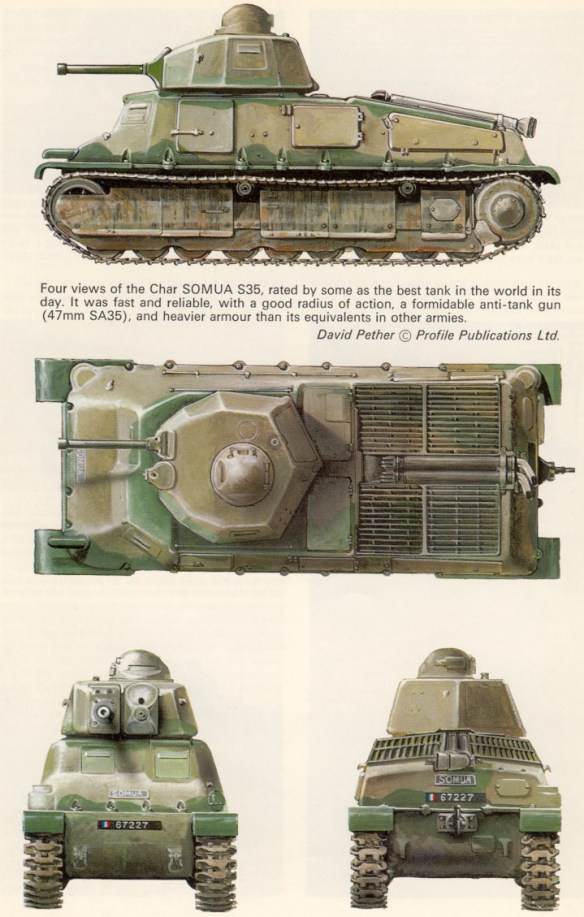Char S-35
Char S-35 = Char SOMUA-35. Char = tank. SOMUA = Societe d’Outillage Mécanique et d’Usinage d’Artillerie; 35 = year of service (1935).
In the early 1930s the French cavalry issued a requirement for a tank to be called the Automitraillesuse de Combat (AMC) and a vehicle to meet this requirement was produced by the SOMUA factory. After trials this was accepted for service as the standard medium tank of the French Army, under the designation Char S-35. It entered service in 1936 and by the time of the capitulation of France (25 June 1940) some 500 had been manufactured.
The S-35’s hull was constructed in three castings (hull floor, front superstructure and rear super structure) which were then bolted together. The driver sat at the left front of the vehicle with the radio operator to his right, both men entering and leaving the tank via a door in the side, although an under floor escape hatch was available for emergency use. The turret, which had electric traverse, was also of cast construction, with a maximum thickness of 2.2in (56mm).
Main armament was the 47mm SA 35 gun which fired either high-explosive or amour-piercing rounds. The engine and transmission were at the rear and were separated from the fighting compartment by a fireproof bulkhead.
For its day the Char S-35 was an excellent tank, having good armour and a 47mm gun which was more powerful that the 37mm gun fitted to PzKpfw III.
It also had some disadvantages. The three piece construction system made for ease of manufacture, but a hit on one of the joins was likely to split the tank wide open, while the small turret meant that one man had to combine the roles of commander, loader and gunner. Finally, there was a general shortage of radios and during the brief campaign some 80 percent of French tanks did not have them, which naturally made command and control very difficult.
Specifications Country of origin: France. Type: medium tank. In service: 1936-1945. Combat Weight: 44,2001b (20,048kg). Dimensions: length 17.9ft(5.5m); width 6.93t (2.1m); height 8.80ft (2.7m). Engine: SOMUA water-cooled eight-cylinder petrol engine, 190hpat 2,000rpm. Performance: road speed 23mph (37km/h); range 160 miles (257km); trench 7.8ft (2.3m); gradient 65 per cent. Ground pressure: 13.1lb/sq in (0.9kg/sq cm). Power-to-weight ratio: 10hp/ton. Armour: hull – 1.6in (41 mm); turret – 2.2in (56mm) maximum. Weapons: 1 x 47mm SA 35 main gun; 1 x 7.5mm coaxial MG. Ammunition: 118 rounds 47mm; 1,250 rounds 7.5mm. Crew: three.
Crécy-sur-Serre: 19 May 1940.
At the time of the German attack in 1940 most French tanks were organised into 13 tank battalions in four Divisions Cuirassées de Réserve (= Reserve Armored Division (DCR); each battalion had 34 tanks and two battalions were usually grouped to form a demi-brigade. In the shambles following the first German attacks, Colonel De Gaulle, who had long been an advocate of armoured warfare, was appointed commander of 4th Armoured Division (11 May), although this formation was very short of equipment and morale was poor. Nevertheless, De Gaulle’s drive and enthusiasm enabled him to lead an attack on the German lines-of-communication at Montcornet on 17 May, but this was seriously disrupted by attacks from ubiquitous Ju-87 Stukas which were called up by radio by the German ground troops as and when required.
De Gaulle’s next attack was against the bridge at Crécy-sur-Serre on 19 May. By this time he had received reinforcements, particularly of artillery and tanks, the latter including two companies (40 tanks) of Char S-35. The 4th Armoured Division reached the bridge, but there was yet another example of the ineptness which characterised the whole French campaign. Arrangements had been made for French fighters to provide air cover for 4th Armoured Division against attack by Stukas, but when the time of the attack (H-hour) was brought forward someone omitted to tell the air force so that the tanks were again heavily attacked by Stukas. Then, when the French tanks had been forced to withdraw, the French fighters arrived to find both ground and air empty.
In this last battle the Char S-35 proved itself to be superior to the German PzKpfw III and IV in almost all respects, and if deployed and directed correctly by commanders and crews with greater faith in its capabilities (and in themselves), it could have turned the tide on several occasions. As it is, however, the Char S-35 is best described as almost a battle winner, since it was so much better than the German tanks facing it and if handled better it might have had a significant effect on the battles in the summer of 1940.
